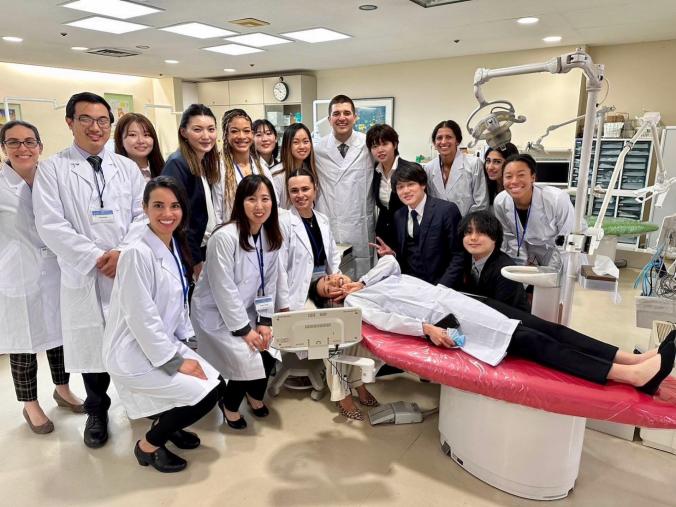Long in the Tooth: UCLA–Japan Dentistry Exchange Program Marks Three Decades

For 30 years, students and faculty from the UCLA School of Dentistry have made regular journeys across the Pacific to Meikai University, just outside Tokyo, and Asahi University, about 75 miles northeast of Kyoto, to share and absorb the latest in dental techniques and technology — and get a taste of the local culture — with their Japanese counterparts.
The unique exchange program, which also brings members of both Japanese universities to the Westwood campus each year, had its genesis in a moment of tragedy — and of healing. On April 29, 1992, Dr. Henry Takei, a professor of periodontics and UCLA, and Dr. Susumu Miyata, chairman of the board of trustees for Meikai and Asahi universities, sat down to dinner in Los Angeles to discuss their desire to create an academic and cultural exchange program. They looked out the window to see the city ablaze. It was the flashpoint of the Los Angeles riots.
As the days of unrest gave way to reflection, Takei and Miyata, along with Dr. Hiroshi Kawazu, a professor at Meikai University, became even more resolved to move forward with their partnership as a means to build bridges of understanding. An agreement was signed later that year, and in 1993, UCLA welcomed the first cohort of Japanese dental students.
To date, more than 430 UCLA and Japanese students have traveled to each other’s countries to participate in the 10-day oral health care immersion program, thanks to support from the Dr. Susumu Miyata Endowed Fund. In addition to the tight bonds forged among students, the exchange has proven fruitful for faculty, with scholars from the three universities collaborating on more than a dozen academic publications and presentations, and UCLA faculty members having taught 44 continuing education sessions for their Japanese peers.
This year — the program’s 30th anniversary and its return after a three-year hiatus due to the COVID-19 pandemic — 10 UCLA students and two faculty members welcomed an equal-sized contingent of students and faculty from Japan in February; during the recent spring break, they reconnected on the other side of the ocean.
Below, participants in the 2023 AUM (Asahi–UCLA–Meikai) exchange reflect on their educational experiences.
“In comparison to the U.S. higher education model, Japanese dental students enroll in a six-year program directly after high school. Although didactically there were some differences, we have very similar curriculums, courses and postdoctoral specialties … from oral surgery to endodontics. Both UCLA and the Japanese universities we toured are very rigorous and thoroughly prepare every future clinician. My visit to Japan through the AUM exchange program was nothing short of incredible. I am honored and extremely grateful I was chosen for this once-in-a-lifetime opportunity.”
— Debby Flores, third-year dental student at UCLA
“In Japan, we obtain student dentist qualifications after our fourth year, after which we can assist dentists in seeing patients. ln most cases we don’t actually treat patients ourselves, with rare exceptions. I was very surprised that American students oversee all treatments from the first consultation! With that said, in both countries, I observed that everyone puts their patients first and treats them with courtesy.”
— Kurumi Unetani, fifth-year dental student at Asahi University
"Seeing Japan's advancements in the field of dental materials, like our tour of a company that makes CBCT (cone beam computed tomography) machines was really fascinating. Many of the materials that I learned about I had never heard of before, and would circumvent many of the issues that I see firsthand occurring in our clinical labs."
— Jack Fang, third-year dental student at UCLA
“The Miyata exchange has given me the opportunity to go out into the international dentistry community. I have served as a chaperone three times, including this year, and by maintaining relationships with doctors I met on previous trips, I had the opportunity to conduct research in Dr. Flavia Pirih’s lab at UCLA in 2018. In that sense, I may be the person who has benefited the most from the program!”
— Dr. Makiko Ishii, professor of periodontology at Meikai University
